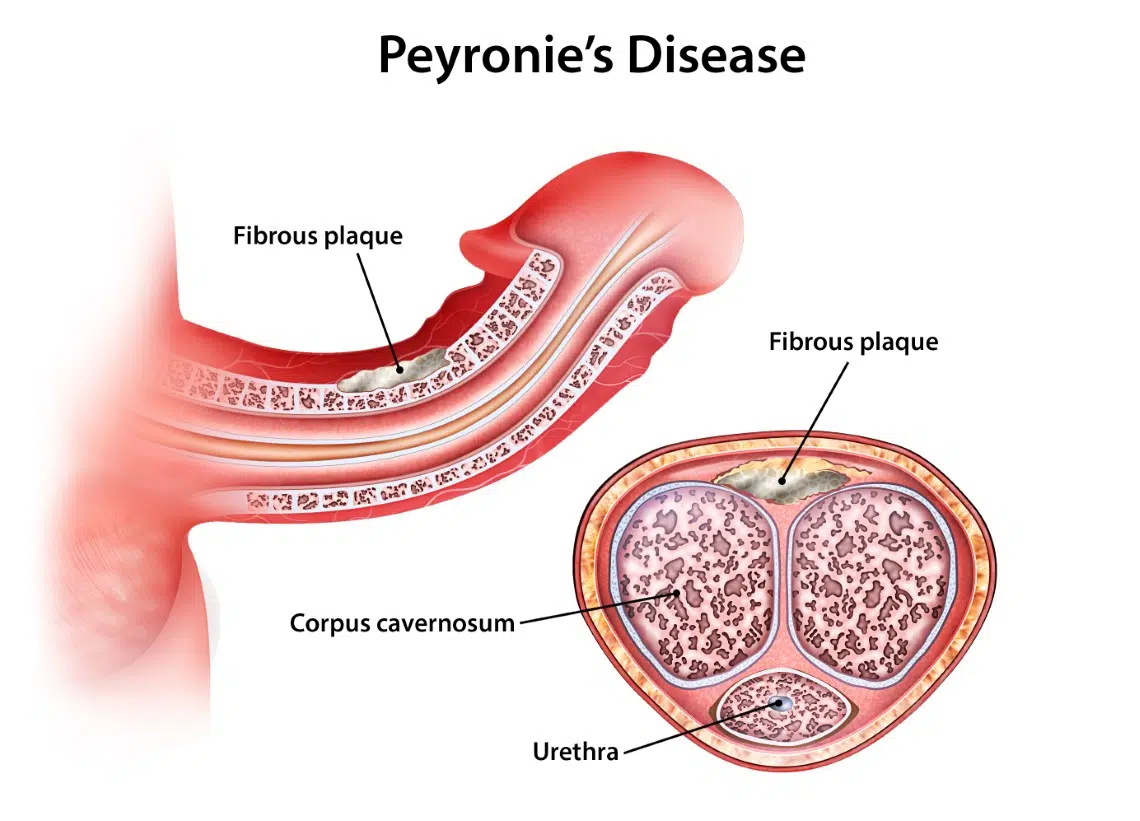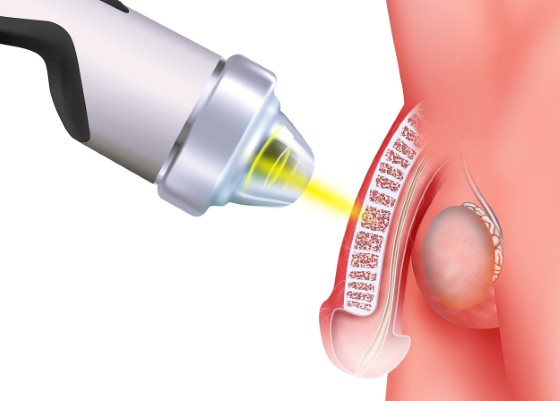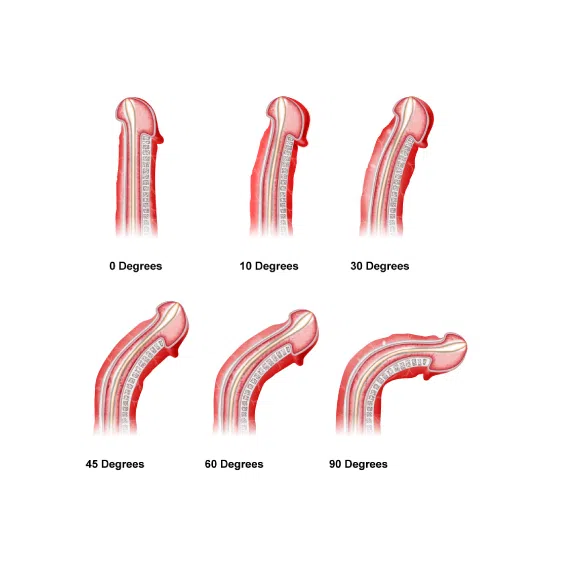If you’ve noticed a bend in your erection, discomfort during intimacy, or difficulties with sexual intercourse, you might be experiencing Peyronie’s disease. This condition, caused by scar tissue formation, can lead to painful erections, reduced confidence and in some cases, decreased erectile function.
While it’s a common issue for men over 50, many suffer in silence, unaware that effective non-invasive treatments are available. At MansMatters, we specialise in cutting-edge Peyronie’s Disease treatment in London, offering advanced, non-surgical solutions that target the root cause of the condition – helping men restore natural sexual function and regain confidence in their intimate health.

What is Peyronie’s Disease?
Peyronie’s disease is a condition that affects the erect penis, causing an abnormal bend or curvature due to the development of scar tissue beneath the skin. This can lead to painful erections, difficulties with sexual intercourse and, in some cases, decreased erectile function. While some men experience mild symptoms, others find that the condition significantly impacts their sexual health and overall well-being.
According to The British Association of Urological Surgeons, it is estimated that Peyronie’s disease affects approximately 6% of men (about 1 in 16) but may affect up to 10% due to under-reporting.
The condition typically progresses through two stages:
The Acute Phase
- This is the initial stage when scar tissue forms, leading to penile pain, inflammation and noticeable changes in curvature.
- Some men also experience erectile dysfunction due to restricted blood flow and nerve sensitivity changes.
The Chronic Phase
- Over time, the scar tissue stabilises and while penile pain may subside, the curvature and associated symptoms often persist.
- Without treatment, this can make sexual activity increasingly difficult and reduce erectile function in the long term.
What Causes Peyronie’s Disease?
The exact cause of Peyronie’s disease is not always clear, but it is believed to result from repeated micro-injuries to the erect penis, which lead to excessive scar tissue formation. Several factors may increase the risk of developing Peyronie’s disease, including:
- Trauma or Injury – Minor injuries during sexual activity or physical exertion can cause scar tissue to form.
- Connective Tissue Disorders – Conditions affecting connective tissue may make some men more susceptible.
- Autoimmune Disease – In some cases, the body’s immune system may mistakenly contribute to excessive scar tissue buildup.
- High Blood Pressure & Cardiovascular Issues – These can affect blood flow, which is crucial for erectile function and penile tissue health.
- Prostate Cancer & Medical History – Some men develop Peyronie’s disease following treatments for prostate cancer or have a family history of the condition.
- Congenital Penile Curvature – Unlike Peyronie’s disease, some men are born with a naturally curved penis, though this does not involve scar tissue formation.
Symptoms of
Peyronie’s Disease
Men experiencing Peyronie’s disease symptoms may notice:
- A distinct curve or bend in the erect penis, often making sexual activity challenging.
- Penile pain, particularly during the acute phase of the condition.
- Hard lumps or plaques beneath the skin, where scar tissue forms.
- Shortening or narrowing of the penis due to tissue changes.
- Erectile dysfunction, either due to reduced blood flow or the psychological impact of the condition.
How is Peyronie’s Disease Diagnosed?
A healthcare professional can diagnose Peyronie’s disease through a physical examination, assessing the degree of penile curvature and the presence of scar tissue. In some cases, additional tests such as ultrasound may be recommended to evaluate blood flow and connective tissue changes.
Treatment Options for Peyronie’s Disease
At MansMatters, we offer non-invasive treatments designed to treat Peyronie’s disease by improving blood flow, breaking down scar tissue and enhancing erectile function. Unlike surgical procedures, our multi-modal approach aims to restore natural function without the risks associated with invasive treatments.
Shockwave Therapy
One of the most advanced Peyronie’s disease treatments, Shockwave Therapy uses low-intensity sound waves to:
- Stimulate blood vessel regeneration and improve circulation.
- Break down existing scar tissue to reduce penile curvature.
- Enhance natural healing responses for long-term results.

Traction Therapy
For men in the chronic phase, traction therapy can help gradually improve curvature by applying controlled stretching forces over time. This method supports scar tissue remodelling and may help restore erectile function.

Electromagnetic Transduction Therapy (EMTT)
This advanced treatment helps promote tissue repair and reduce inflammation, making it beneficial for men experiencing painful erections or persistent discomfort.

NanoVi EXO and Near-Infrared Spectrum Therapy
These complementary therapies work at a cellular level to enhance the body’s natural ability to repair damaged tissue, further supporting improvements in erectile function and sexual health.

What to Expect in the MansMatters Clinic
We are experts in the field of men’s health. We offer our patients the safest, most advanced and effective men’s health treatments in a comfortable, relaxed and premium environment.
Complimentary Initial
Consultation
This 20 minute consultation with our knowledgeable clinical advisors to assess your goals, initial evaluation of your medical history, and determination of the best approach to achieve the desired outcomes.
Consultation
Pre-Treatment
This involves detailed information on the treatment being undertaken and allows the practitioner to answer any questions you have, as well as providing instructions on preparing for the treatments, including any pre-requisite actions prior to undertaking the treatments.
Treatment
We are committed to solving your men’s health challenges by administering procedures and providing personalised care. Let us guide you with confidence and comfort at every step of your journey, reclaiming the best version of yourself.
Post-Procedure
Consultations
We provide personalised attention and support for your comfort and recovery. With our expert team by your side, we ensure a smooth journey to renewed confidence, delivering optimal results and satisfaction.
Why Choose MansMatters for Peyronie’s Disease Treatment?
MansMatters is Europe’s leading non-invasive men’s health clinic, offering expert-led solutions tailored to male sexual health concerns.
Our Approach:
- Non-surgical, pain-free treatments – Non-invasive procedures, ensuring minimal discomfort.
- Exclusive multi-modal technology – We combine six leading technologies for optimal results.
- Expert-led, judgement-free care – Our team specialises exclusively in male sexual health.
- High success rates – We focus on treatments that deliver measurable improvements.
If you are experiencing Peyronie’s disease symptoms, contact us today to discuss how our cutting-edge treatments can help restore your sexual function.
FAQs
Frequently Asked Questions
How Do You Get Peyronie’s Disease?
Peyronie’s Disease is usually caused by injury or micro-trauma to the penis that leads to scar tissue forming inside the erectile tissue. Repeated bending during intercourse or accidental impact during sport can trigger the condition.
Is Peyronie’s Disease a Common Problem?
Yes. Around 1 in 10 men experience some degree of Peyronie’s Disease, though many never seek help. Severity varies from mild curvature to significant bending that affects sexual activity.
What Are the Main Symptoms of Peyronie’s Disease?
Typical signs include penile curvature when erect, lumps under the skin, pain during erections, and reduced length or girth.
When Should I See a Men’s Health Specialist?
The sooner you seek help, the better the outcome. Early-stage Peyronie’s responds well to non-invasive therapy. Book a consultation if you notice any curvature, lumps, or pain.
How Is Peyronie’s Disease Diagnosed?
Diagnosis is usually made through a physical examination. A men’s health specialist will gently feel for scar tissue and may use ultrasound to measure plaque and blood flow.
What Causes Peyronie’s Disease?
Injury is the most common trigger, but genetics, connective-tissue disorders (like Dupuytren’s), diabetes, and smoking can also increase risk.
Can Peyronie’s Disease Just Go Away?
Very rarely. Mild cases may stabilise, but curvature or plaques almost never disappear completely without treatment.
Can Peyronie’s Disease Be Prevented?
Not entirely, but maintaining good penile health, avoiding vigorous or painful sex, and treating erectile dysfunction early can lower the risk.
Can High Blood Pressure Contribute to Peyronie’s Disease?
Yes. Poor circulation caused by hypertension can lead to scar-tissue formation and worsen penile curvature.
How Is Peyronie’s Disease Treated?
Modern treatment focuses on non-surgical, regenerative solutions such as PRP/HA Therapy, EMDA, Focused Shockwave Therapy, EMTT, Photoactivation, NanoVi EXO, and the Tesla Chair, all available at MansMatters. These therapies work together to remodel plaque, restore blood flow, and improve curvature without surgery.
Traditional surgical options include the Nesbit procedure, plication, grafting, and penile implants for severe or advanced cases.
Why Is Focused Shockwave Therapy Used as a First-Line Treatment?
It’s the only clinically proven, non-invasive method that can reduce plaque, soften curvature, and restore function, without surgery or injections.
Is Shockwave Therapy Painful or Invasive?
Not at all. Most patients describe it as a gentle tapping sensation. There’s no downtime, bruising, or discomfort afterward.
How Many Shockwave Sessions Are Recommended?
Typically 6-12 sessions, held weekly. More chronic cases may need extra sessions for the best result.
Are There Any Side Effects from Shockwave Therapy?
There are no known side effects. You can resume normal activity immediately after each treatment.
What Is EMTT and How Does It Help?
EMTT (Electromagnetic Transduction Therapy) uses pulsed magnetic fields to accelerate healing, improve blood flow, and enhance the effect of shockwave therapy.
What Is NanoVi EXO and Is It Safe?
NanoVi EXO is completely safe and non-invasive. It helps repair cell damage and reduce oxidative stress, a key cause of scar formation in Peyronie’s Disease.
What Is Photoactivation and How Can It Help?
Photoactivation uses precise wavelengths of light that are absorbed by the cells, boosting their energy output and repair activity. In Peyronie’s Disease, this helps reduce inflammation, remodel fibrous plaque, improve tissue elasticity, and enhance the results of regenerative treatments such as shockwave or PRP therapy.
How Long Will Treatment Results Last?
Most men experience long-term improvement. Occasional maintenance sessions may be recommended to preserve results.
How Does Peyronie’s Disease Affect Sex Life and Relationships?
Curvature or pain can make intimacy difficult, leading to frustration and stress. Successful treatment often improves both confidence and relationship satisfaction.
Why Do Men Choose MansMatters for Peyronie’s Treatment?
Unlike clinics that rely solely on surgery or basic injections, MansMatters specialises in high-energy Focused Shockwave Therapy combined with PRP/HA Therapy, EMDA, EMTT, Photoactivation, NanoVi EXO, and the Tesla Chair, offering one of Europe’s most advanced and comprehensive non-invasive programmes for lasting results
Let's Start Your Journey
to Better Health
Take the first step towards addressing your concerns with complete discretion. Choose between a free
20-minute phone consultation with our medical advisor or visit us for a thorough in-clinic assessment.

